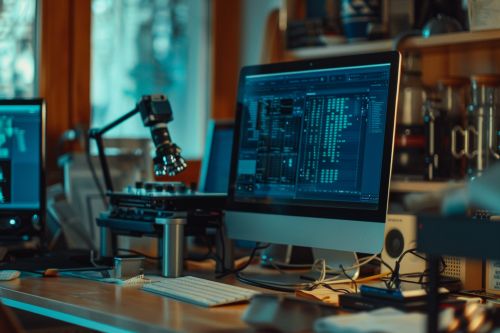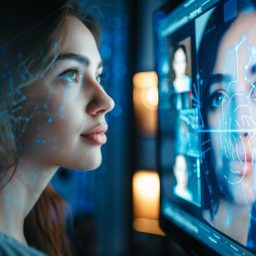

Technology trends significantly influence the quality of automatic translation. Not long ago, machine translation was producing incomprehensible output. However, thanks to advancements in artificial intelligence, neural networks, and machine learning algorithms, today we can enjoy natural-sounding content.
AI-generated content allows creators to produce high-quality materials with minimal human intervention quickly. Automatic translation facilitates the daily work and personal lives of many people.
Contents
The history of automatic translation
Automatic translation, though it may seem like a modern invention, actually dates back to the 1930s. It was then that the first machines were used for military purposes.
Machine translation: Concept
Initially, emerging technologies focused on simple algorithms based on grammatical rules and dictionaries. The concept of machine translation was formulated by Warren Weaver, who first mentioned using computers to translate texts.
Emerging technologies: Rule-based machine translation
Subsequent decades saw the development of rule-based machine translation, as well as statistical machine translation methods. It dominated the industry in the 1990s and early 2000s. This system utilised large text corpora to model translations based on the probability of words and phrases in both languages. Although these methods were a step forward, they still struggled with literal translations and a lack of contextual understanding.
New technology trends
Contemporary machine translation is usually done by neural networks, specifically deep learning models. Introduced by Google in 2017, the Transformer model uses so-called attention mechanisms, which allow the model to focus on different parts of the text during translation. This has significantly improved the quality of translations.
Thanks to neural networks, automatic translation has become more tailored to the specific needs of users. The ability to translate in real-time, an increasingly more in-depth understanding of context, and the capability to handle idioms have enhanced the translations.



Application of generative artificial intelligence
Automatic translation is breaking down language barriers among social media users. Facebook and X (formerly Twitter) translate posts, comments, and messages with advanced mechanisms on the fly. Their users interact easily without knowing the same language. This means you may read and respond to tweets from a user in Japan or comments in Italian without any trouble.
Law, medical care, engineering
In law, medicine, and engineering, automatic translation aids in the translation of specialised documents. It enables companies to launch products on international markets swiftly without the need to hire numerous translators to translate product descriptions, user manuals, and technical specifications.
Customer service
Automatic translation is used in customer service through chatbots. Companies utilise artificial intelligence to conduct conversations with clients in various languages. Chatbots provide answers to frequently asked questions and reduce the workload for the team.
Science
Automatic translation also enhances access to international scientific achievements for students and researchers worldwide. Students use educational materials in different languages, and researchers easily share their work. Universities and research centres employ automatic translation for scientific articles, books, and other publications.
Travelling
Software development facilitates better communication between travellers and staff in restaurants and hotels abroad. Apps help tourists communicate in hotels, restaurants, and while sightseeing, making travel less stressful and more satisfying as they manage to navigate language barriers.
Neural networks
Neural networks form the foundation of modern automatic translation. How do they work? They analyse and process text and learn to recognise language patterns based on vast datasets of textual information.
Traditional models relied on rigid grammatical rules or statistics. Neural networks understand words in context, rather than just recognising them as individual terms. This results in much greater precision in translations and brings them closer to human work in terms of quality.
Machine learning: Training artificial intelligence models
Machine learning and its advanced form, deep learning, power automatic translation. It enables systems to learn through experience, which involves analysing and adapting based on input data (texts in various languages). As a result, machines do not need to be explicitly programmed to perform specific tasks.
Deep learning allows for the analysis and processing of language at a level previously unattainable. Technologies such as LSTM (Long Short-Term Memory) and the aforementioned Transformers process long data sequences (e.g., sentences) while retaining context from past information. This enhances the accuracy of translation models.
Integrated translation
The integrated translation is becoming part of everyday use in apps and online platforms. It embeds translation directly within software. Users gain access to translations of content without leaving the application. This enhances the fluidity of interactions.
For e-commerce platforms for international markets, integrated translation allows buyers to browse product descriptions and offers in their own language. The system automatically detects the user’s language and provides the appropriate translation. A simplified shopping experience fosters customer trust and loyalty.
The integration of translation into applications significantly improves the quality of customer and user service. Companies communicate effectively with clients from different cultures. Additionally, a hassle-free translation enhances the user experience.
How to use artificial intelligence in content creation?
Content creation with AI technology can be tailored for various platforms. Social media posts for Instagram and Twitter need to be short, concise, and eye-catching.
Artificial intelligence optimises posts for increased interaction and user engagement. It does so by analysing which types of posts generate the most responses.
AI also aids in writing longer articles. Content creation software discovers popular trends within specific industries and suggests topics that address readers’ questions based on this data.
AI assists in automating and crafting detailed product specifications, user manuals, and other documents. The tools organise information to make it clear and accessible to the target audience.



AI content generators
AI text generators are based on language modelling. They select subsequent words in a sentence based on previously input data. These tools produce coherent, understandable, and convincing texts. Sometimes, differentiating them from content written by a human can be challenging.
Copywriting
AI is used to create compelling product descriptions, advertisements, or blog posts.
Transcription
Text generators create captions for videos and presentations.
Content personalisation
AI analyses user data and generates personalised email messages that increase the likelihood of a response.
AI text generators are extremely effective in scaling content production. With these tools, companies quickly produce a large volume of high-quality materials.
SEO optimisation
Artificial intelligence crafts content that is well-tuned to the algorithms of search engines. Moreover, it performs an analysis of search trends and identifies keywords that should be incorporated into content to increase visibility.
Algorithms suggest best practices for article structure, including the use of headers, paragraphs, and correct text length. All to make the text more search-engine friendly.
AI automatically proposes internal linking strategies. It finely adjusts content to align with Google’s algorithms, increasing its chances of achieving a higher search result ranking. Consequently, this leads to increased website traffic and improved conversion rates.



Machine translation and AI-driven content creation
Our translation agency utilises cutting-edge AI technologies to provide accurate translations in various languages for business clients. This is the perfect solution when you need a quick translation of large volumes of content.
Thanks to advanced algorithms, we offer translations that faithfully convey the original content. We also provide the option of post-editing by an experienced translator who will verify the text’s accuracy.
We provide translation and full support in creating multilingual content that resonates with people around the world. To learn more, contact us.
Images generated by AI.










